America is a melting pot, full of different people and cultures. Among the numerous offerings from around the world, Asian food is among the most popular. In fact, it is the largest growing food industry in America. Among the many different types of Asian food, Chinese stands as a giant, a favorite cuisine in the United States.
American Chinese food tends towards sweetness and heavier flavors, while authentic Chinese food is lighter and more savory. In addition, the use of vegetables is heavier in authentic Chinese food, whereas meat takes precedence in American Chinese food. They have their own unique dishes as well.
Both cuisines are rooted in the same cuisine, but they exist in vastly different locales. Due to differences in geography and target audience, the two versions of the same food differ greatly. Today, the differences between the two types of Chinese food will be examined in detail.
The Difference between American Chinese Food and Authentic Chinese Food
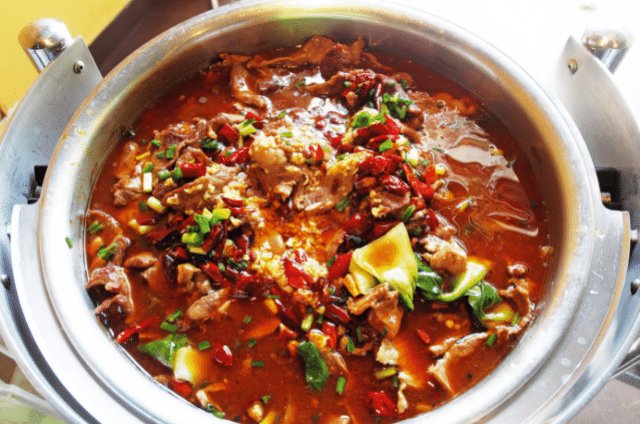
The difference between American Chinese food and authentic Chinese food is not as simple as a single thing. In fact, although they have similarities and a common origin, they are vastly different cuisines. The differences include the general flavor profiles involved, the ingredients used, and the dishes served as a whole.
American Chinese food dates back to the 1800s, coming into being with the first big wave of Chinese immigrants to the US. After picking up steam many years later, it started to become what America has today. Essentially, the difference between the two boils down to what it was back then, which was a way to make money for immigrants.
With Chinese immigrants looking to make a living in a new country, they turned to things they knew, like food. However, serving dishes authentic to the area they came from proved to be less than fruitful, sometimes even impossible. Therefore, the food that appeared and grew popular was food rooted in American flavor profiles.
Americanized
This link brings you to the origin history of Chinese food
There is an important distinction to make when talking about these two types of Chinese food. While the word fusion gets thrown around, American Chinese food does not fall under that umbrella. It does not combine the two food cultures and is Americanized instead, which means that it is Chinese food that has been adapted to American tastes.
This is an important distinction to make because a lot of what makes Chinese food authentic has been changed to make it “fit in” with American food preferences and tastes. The difference between the two is quite remarkable, giving the two cuisines of common origin an array of differences.
In fact, you probably will not find anyone from China reminded of home by the common dishes found in American Chinese restaurants. More than that, there are instances of Chinese restaurants having two menus, one for Americans and one for Chinese customers with traditional tastes.
The Difference in Flavor Profiles
There is a saying about American Chinese food, which is that it is sweet and sour everything. While this may not be the case, at least not entirely, there is a certain truth to it. A great number of popular dishes served in American Chinese restaurants work off the same general principle, which is sweet or salty and heavy.
On the other hand, authentic Chinese food focuses on a different flavor profile entirely. While the vast number of cuisine types in China makes it difficult to generalize, there is a definite leaning toward lighter, savory flavors. There is also a great deal more spice in authentic Chinese food. It all boils down to the people the dish is meant to be served to.
In China, each area has its own flavor preferences. Below are some of the various areas in China and the flavors that they are known for:
- Central and southern China, such as Sichuan, are known for spicier food.
- The coastal areas and the northern parts of China enjoy saltier food.
- Eastern China, including Jiangsu and other regions, enjoy the sweeter fare.
- In the south and in Shanxi, sour food thrives.
While some of the traditional flavors from authentic Chinese food made their way to America, the vast majority fell away, leaving American Chinese food with a flavor profile suited for the country and for a broad audience. After all, most of the dishes you find in one American Chinese restaurant, you can find in every similar restaurant in America.
From Coast to Coast
Examine one of the most incredible parts of American Chinese food, which is the fact that you can find almost identical menus and recipes in restaurants across America. It is a phenomenon of sorts that a vast majority of Chinese restaurants in the US stick to the same flavor profiles and dishes. Sometimes, the entire menus are the same.
While there is some variation depending on location, and while preparation might not always be the same, the American Chinese food found in restaurants around the US is truly similar. As mentioned above, authentic Chinese food is not the same.
Whether it be in China or an authentic restaurant somewhere else in the world, there is a great deal of variety in authentic Chinese food. Different regions have different flavors and dishes, and even within the same style, there might be variations depending on locale and cooking method.
The differences in authentic Chinese food can be staggered, especially compared to a static, nationwide menu.
The Difference in Ingredients
Flavor profiles are not the only thing that remains constant when it comes to American Chinese food. In fact, with the same flavors and dishes, you find a lot of similar ingredients in an American Chinese restaurant. Think about some of the most popular dishes. How many of them are breaded?
While the addition of breading itself is a huge departure from authentic Chinese food, it goes further than that. Ingredients from the vegetables used to the thickness and types of wrappers are all different. A few of the things you see in American Chinese food that are not likely to appear in authentic Chinese cooking are:
- Broccoli
- Flour
- Dairy
Authentic Chinese cooking uses a variety of vegetables, but broccoli is not one of them. The same goes for flour and dairy, with lactose intolerance being prevalent among the people in China. These differences end up influencing everything, from taste to preparation, especially dishes. However, the differences do not end there.
Meat vs Vegetables
The first thing to know about authentic Chinese food is that it includes a vast number of different meats and vegetables. American Chinese food is the opposite, where the lack of variance across the country is a mystery. Some of this comes from the expansive diet in authentic Chinese food, which includes things like:
- Offal
- Insects
- Snakes
Offal refers to organ meat, things like kidneys and livers. While all of the above proteins are eaten around the world, with some even finding their way into certain American dishes, they are not commonplace as they are elsewhere. There is a similar trend with vegetables, with a vast number of different offerings existing in authentic Chinese food.
More than the variety, the mere prevalence of meat in American Chinese food eclipses its authentic counterpart. While American Chinese food is meat-centric, with almost every dish revolving around a large portion of protein, authentic Chinese food focuses on vegetables.
While authentic Chinese food does include protein, it comes in much smaller portions. In fact, tofu is often used to improve the amount of protein in a dish, whereas there is no danger of American Chinese food lacking protein. If anything, most American Chinese food lacks vegetables, the staple of authentic Chinese dishes.
Vegetables
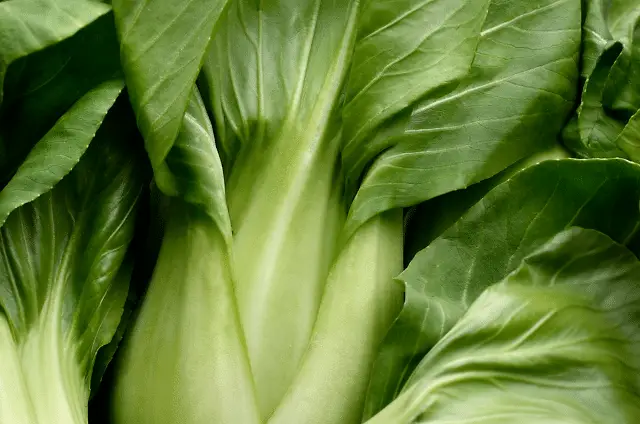
So, authentic Chinese food is vegetable-forward, eclipsing the number of vegetables seen in most American Chinese dishes. However, it is not just the amount of vegetables but the variety, the same as meat. In fact, many of the vegetables you see in American Chinese food have no place in authentic Chinese cooking, including:
- Carrots
- Broccoli
- Yellow Onions
While that may seem like a big blow to a number of popular American Chinese dishes in terms of authenticity, the sheer amount of vegetables used in authentic Chinese cooking that are not found in American Chinese food is staggering, with just a few being:
- Bitter Cucumber
- Pomelos
- Yard-Long Yams
While this does not mean that these ingredients cannot be found in either the US or China, they are not likely to be found in the average American Chinese or authentic Chinese restaurant. This difference in ingredients is not only found with vegetables and meat either.
Fish
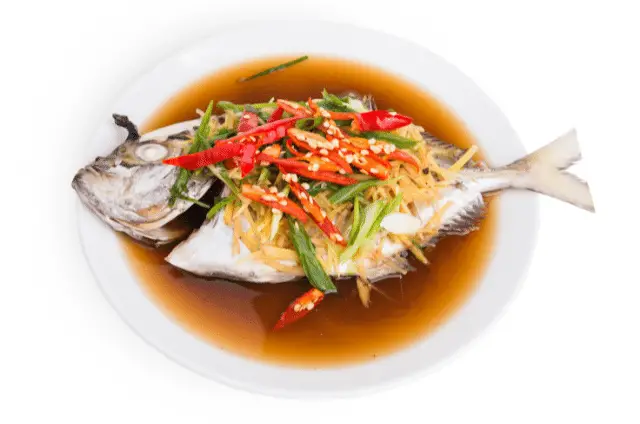
While fish is meat, it deserves special mention because it is one of the things you will not see as much of in American Chinese food. In fact, many American Chinese restaurants have little to no seafood offerings.
Perhaps the lack of fresh fish throughout the US is one of the main reasons, but there is no doubt that traditional American Chinese food lacks when it comes to seafood. Within authentic Chinese food, fish is a much bigger player.
Even when discussing dishes as a whole, fish needs to be mentioned. After all, sweet and sour dishes do not appear in authentic Chinese food, aside from one dish known as sweet and sour fish. Not only is the dish far different from American Chinese sweet and sour, but fish is one of the only meats not to get the sweet and sour treatment.
The Difference in Preparation
Preparation cannot be ignored when discussing American Chinese food and authentic Chinese food. After all, many of the differences in flavor profile stem from the way the food is prepared. For starters, the sheer amount of breading and frying involved in American Chinese food is shocking.
Almost every dish in American Chinese cooking can be made through stir-frying. While this is not an issue in and of itself, it does limit the variety in many of the dishes. On the other hand, in authentic Chinese food, there are many different preparations for meats and vegetables, all of which are commonly seen. Some of the methods are:
- Stewing
- Braising
- Steaming
- Fermenting
While none of the methods are revolutionary, having been around for a long time globally, they are rarely seen in American Chinese food. Instead, you see stir-fried and deep-fried food on the menu. Part of this is due to the ease of making food that way, and another is that it fits the palate of many Americans, now and back when it started.
Moreover, the sauces used are all prepared in a similar fashion. Most start with similar ingredients centered on salt and sugar. Then, they are adjusted to the dish they go into, mixed in, and thickened with cornstarch and water. Seeing as a majority of dishes have a similar style of preparation, it is not as big a surprise that the tastes can be similar.
Bones
American Chinese food and authentic Chinese food share a different opinions on bones. If you look at American Chinese food, even if the dish is not breaded and fried, it is likely that it centers around meat. More aptly, it centers around sliced meat. This distinction is important because it is a phenomenon unique to the American version of the cuisine.
Within authentic Chinese food, bones are not a rarity. In fact, authentic Chinese food makes many meals with the bones included, whether it be in fish or chicken. You are unlikely to see most of the dishes pulled from the bone or sliced, a trend that is dominant in American Chinese food.
The Difference in Dishes
The vast differences in every part of the cuisine, from the overall flavor profile to the ingredients used and the way they are prepared, have resulted in vastly different dishes. In fact, some of the most popular dishes in the American version did not even exist in the authentic version.
To understand the two cuisines, knowing where the differences lie is important. However, it is equally important to see what the differences look like by examples.
Therefore, the following sections will detail a few dishes that are exclusive to American Chinese food and do not exist in authentic Chinese food and some comparisons between similar dishes from both cuisines.
The Fortune Cookie
Everyone who has eaten American Chinese food is aware of what a fortune cookie is. While it might be out of order to start with dessert, the fortune cookie is such an iconic representation of American Chinese food that it deserves immediate attention.
The humble cookie, folded from circles and full of prophetic sayings, is a staple in any American Chinese restaurant. They are so ingrained into the culture that they have their own superstitions, like:
- It is good luck when the cookie lacks a fortune
- Two fortunes in one cookie canceling each other out
The interesting part is that fortune cookies have different meanings attached and are something everyone gets upon eating at an American Chinese restaurant, yet they are not even Chinese in origin. Desserts such as oranges or watermelon are what you might find in authentic Chinese food.
As for the fortune cookie, its origin is Japan, something believed to be popularized by Japanese immigrants. And on that note, fortune cookies are not the only Japanese food seen in American Chinese restaurants.
Sushi
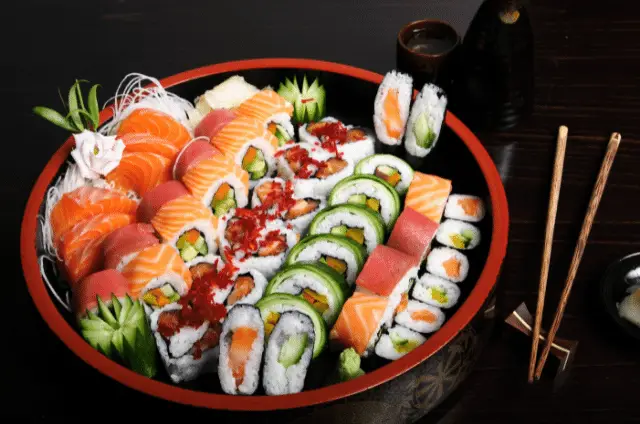
Sushi is not Chinese food, authentic or otherwise. However, even though sushi is not an authentic Chinese cuisine, belonging to Japan, just like the fortune cookie, it is seen everywhere with American Chinese food.
Not all American Chinese restaurants will be found with a sushi bar. However, there are many times when an American Chinese restaurant will also offer sushi, and it is not seen as strange.
While this is not Chinese food, even by American Chinese food standards, it is further proof of the difference between American Chinese food, the restaurants that serve it, and authentic Chinese food.
(Check it out: Chinese Food VS Japanese Food)
General Tso’s Chicken
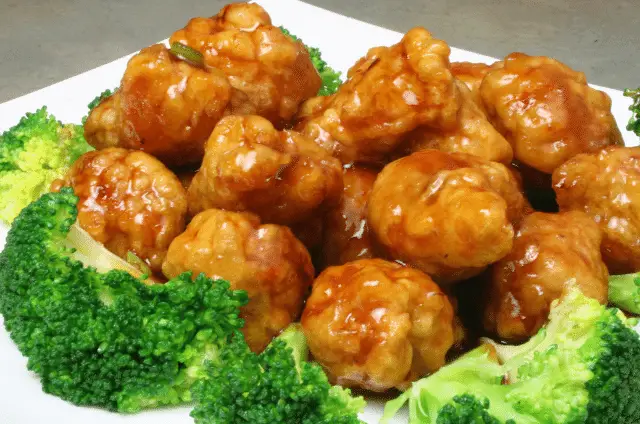
General Tso’s chicken is a very small step towards authentic Chinese food. Not through mimicking or even coming close to an actual authentic Chinese dish but in the fact that General Tso was a famous historical figure in China, and because the dish does have a Hunanese-like flavor.
That is about all there is to be said when it comes to General Tso’s chicken, which does not even have a similar alternative in authentic Chinese food. The reason it stands out from most other dishes is that it is actually the most popular dish in America. It makes sense when the dish as a whole is examined, though:
- Breaded
- Fried
- Heavy Sauce
- Sweet Flavor Profile
It is a dish that embodies American Chinese food, and it is not the only dish that stands apart from authentic Chinese food flavors and preparation.
Many American Chinese Dishes Do Not Appear In Authentic Chinese Food
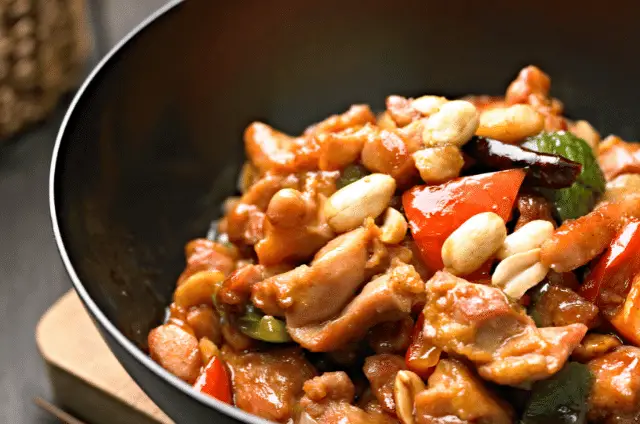
General Tso’s chicken is not the only American Chinese dish with no equivalents in authentic Chinese food. Many of the dishes share the same quality, being almost entirely American despite the slight Chinese influence. Among the more popular dishes that do not have much of an equivalent are:
- Beef and Broccoli: Beef and broccoli are some examples of different ingredients leading to a new dish. With broccoli not being readily available in China, beef and broccoli never had a chance to be invented, and its flavor profile unmistakably belongs to American Chinese food.
- Crab Rangoon: Imitation crab and cream cheese are big parts of this dish, pretty much the only parts. Remember that authentic Chinese food does not include dairy, so these are unmistakably American Chinese food.
- Orange Chicken: Orange chicken was created by the co-founder of Panda Express. It is another popular dish that you will not find in authentic Chinese cooking. While there is a similarly-named dish, citrus peel chicken, it has little in common with this breaded, heavily sauced American Chinese counterpart.
The simple truth is that most American Chinese food is different from the authentic Chinese food you would find. Even if names and certain flavor profiles are similar, with the heavy focus on bread, meat, and a general lack of variety, American Chinese food is predictable, if not downright shallow compared to authentic cuisine.
Egg Rolls Versus Spring Rolls
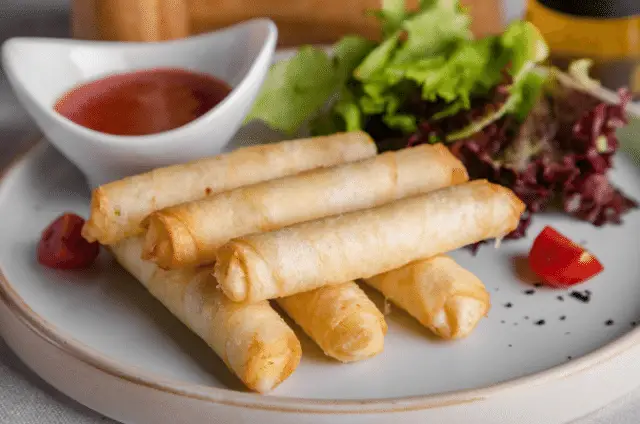
A great example of the differences as a whole is the simple but beloved egg roll. In American Chinese food, there are few items as iconic as the egg roll. An appetizer, an entire meal, they can serve as both. However, they are vastly different from their origin, the spring roll. In fact, the only thing they really share is their shape.
- The Outside: Egg rolls are wrapped in a thick, crispy wrapper, made with flour, and coated in egg. It is crunchy and rich, like many other dishes in American Chinese cuisine. Spring rolls are wrapped in a thinner wrapper, usually rice paper. While they can be crunchy, they are also eaten raw.
- The Inside: Egg rolls stick to the American Chinese style yet again, stuffed with meat and vegetables, all savory in nature. It is often greasy as well. Spring rolls primarily consist of fresh vegetables, perhaps cooked but potentially raw, the same as the wrapper.
- The Preparation: Egg rolls display their American Chinese style yet again, fried and made crispy, even displaying a bubbly exterior. On the other hand, spring rolls are baked, rarely fried, or eaten without being cooked at all if the ingredients allow.
Few foods represent the differences as well as egg rolls, with every aspect of the food differing. Of course, there is some speculation as to the exact origin of the egg roll, but there is no doubt that the dish has found an iconic place in American Chinese food.
Fried Rice
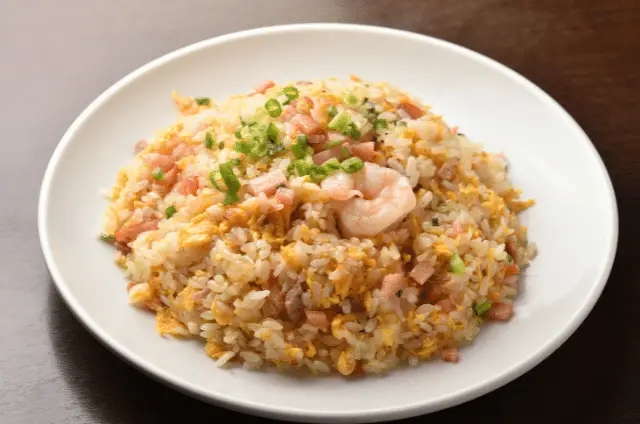
Fried rice serves as another prime example of the differences between the two cuisines of common origin. While the basics of the dish in both cuisines are the same, consisting of day-old rice, soy sauce, and other seasonings, there are a number of things that make the American Chinese version stand out as different.
Mainly, the vegetables included in many versions of American Chinese fried rice are not readily available in China. Therefore, they would not be seen in authentic Chinese food. A few such vegetables are carrots and onions, and even the addition of meat.
While not all fried rice in authentic Chinese food is without meat, it is not as simple as adding it to basic fried rice. In fact, there are many variations on fried rice, each suited for the meat added. In American Chinese food, fried rice is a more basic dish, with the meat itself being the main variation.
Sauces

Sauces are in a sweet spot between being an ingredient and being a dish, especially soy sauce. After all, soy sauce’s main use is as a seasoning, being a key component in a massive amount of dishes in both American Chinese and authentic Chinese food. However, it serves as a condiment as well.
Duck sauce is a different example. Based on the authentic Chinese plum sauce, it is an Americanized version. It utilizes apricots, giving it a very sweet taste. However, apricots are uncommon in China, meaning it is quite a distance from authentic Chinese inspiration.
Culture through Food
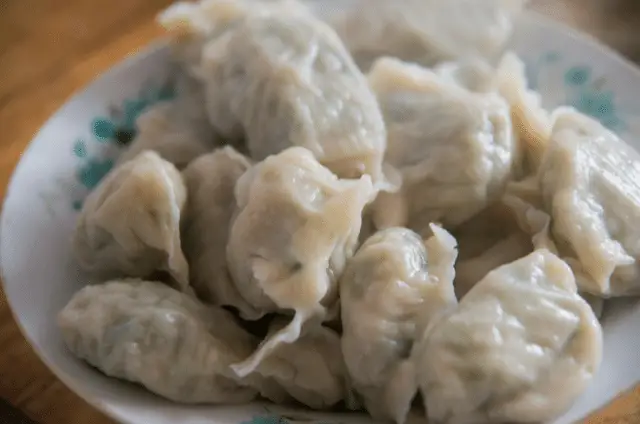
Authentic Chinese food is rooted in a long history, with dishes that carry a great deal of meaning and symbolism. Whether it is the longevity noodles used to celebrate a birthday and wish people a long life or the glutinous rice dumplings for their Dragon Boat Festival, there are many instances of food carrying meaning.
- Dumplings: They appear similar to a traditional piece of gold or silver, so they represent wealth and are eaten for the Chinese New Year. (Check it out: Chinese New Year Food: Top 10 Lucky Foods and Symbolism)
- Sweet Round Sticky Rice Balls: When placed in soup, these represent togetherness and reunion, appearing in the Lantern Festival.
- Mooncakes: For the Mid-Autumn Festival, they are used to symbolize family unity.
All of this symbolizes is lost in American Chinese food, though it has its own traditions, even if not quite as significant. Namely, things like the famous oyster pail, which is the official name of the white box with a wire handle known to many as a Chinese food take-out box. Perhaps fortune cookies fall into the same category.
Medicinal Food
A major category of food in authentic Chinese food that does not exist in American Chinese food is medicinal food. In China, medicinal food is nothing new. In fact, it has a long and storied history. It is a mixture of food and medicine, working in tandem to create a health-improving diet.
The actual recipes and traditions behind it are far more complex, but the ultimate goal is to create dishes with various ingredients to benefit human health. A great deal of research has gone into understanding the human body, the different ingredients, and how they interact.
Medicinal food is just another example of how varied authentic Chinese food can be. On the other hand, American Chinese food has an entirely different reputation for how it affects the human body. Heavy food and a heavy feeling after. Between that, heavy sauce, and fried food, it is no wonder.
Conclusion
American and authentic Chinese food stand as two vastly different cuisines. While they share the same general origin, a few ingredients, and the occasional flavor profile, they are different in even more ways. However, it is true that they are two different worlds, with the ingredients used and those who eat them differing greatly.
Looking at them through contrast and comparison reveals many differences, but it also poses a question: should they be compared? Perhaps it is better to call authentic Chinese food traditional. After all, the two are practically entirely different cuisines.
